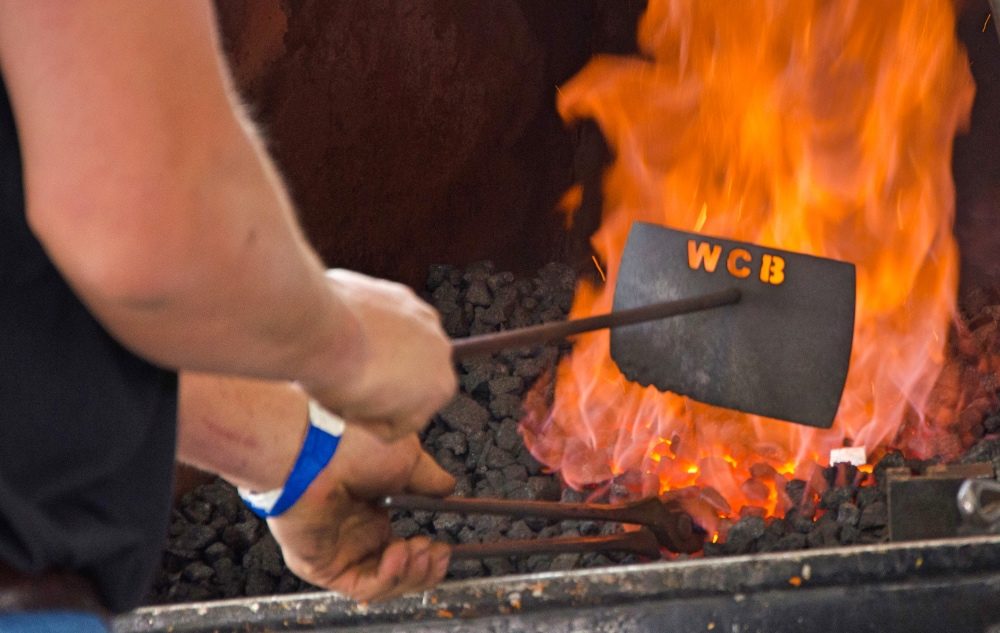Pictured Above: The Goshen Stampede is adding the World Championship Blacksmiths to its already deep farrier roots. The Stampede takes place June 15-17, 2018, at the Goshen Fairgrounds, 116 Old Middle St. in Goshen, Conn.
World Championship Blacksmiths fans no doubt have noticed a new destination on its 2018 tour — the Goshen Stampede.
In its 13th year, organizers of the Goshen, Conn., event have been working hard to add the WCB to its roster of events.
“We’ve been trying to get the WCB for the previous 3 years,” says Sean O’Neill, president of the Stampede. “We just couldn’t get it to work out.”
The WCB isn’t just a short-term event for the Stampede, O’Neill says.
“I’m happy to say they have found a home,” he says. “They have an open invitation as long as they want it.”
O’Neill considers the Stampede to be the perfect venue. After all, he’s been a farrier for nearly 3 decades and places a premium on the industry’s involvement in the event.
“This is my way of giving back to the farrier industry,” O’Neill says. “We have a couple of horseshoers who own a lot of rodeo stock — bulls and saddle broncs — for this event, as well as the National Finals Rodeo [NFR] in Las Vegas, Nev. Another farrier is a rodeo judge. We have a few farriers in the circuit who ride bulls and saddle broncs. By bringing in the WCB, we’re growing the farrier aspect of the Goshen Stampede even more.”
Newtown, Conn., farrier George Fitzgerald has been involved with the Stampede from the ground floor, partnering with Shawn Graham of The Painted Pony Championship Rodeo to provide rough stock for dozens of rodeos across the country — including the NFR.
“I’ve always wanted to raise cattle,” says the International Horseshoeing Hall Of Fame member. “I could never afford a big farm or the property you need to raise cattle. The closest I get is the rodeo bulls that we herd and exercise. It means a lot at my age that I accomplished what I wanted to do — I wanted to be close to cattle. I’ve been with horses my whole life and it’s nice to have a second passion.”
Hoof care for rough stock such as saddle broncs and bareback broncs is a completely different animal than it is for the hunters and jumpers that Fitzgerald handles in his practice.
“They are tranquilized in the chute and let them come out and they lay down in the arena where they are worked on,” he explains. “Or we tranquilize them, put them on a hydraulic table and turn them up on the side so they don’t get hurt. The safest way to do it is on the table.”
Despite the jumping and bucking, the horses don’t have tendon or ligament injuries. However, a herd might see two or three abscesses a year.
“You never know what a bronc is going to do,” Fitzgerald says. “They’re always in mischief because you can’t handle them and they’re herd animals. You never know what they’re going to step on. They get stone bruises during turn out or even in the rodeo arena. We try to pick up all the rocks in the arena, but you can’t get them all.”
Treating an abscess for rough stock is much the same as other horses, but the follow-up is different.
“Once you treat the abscess and bandage the foot, you can’t just change the bandage the next day because it’s such a hassle putting them down or putting them on the table,” he says. “That’s where it gets complicated. To soak their feet, we put them in the chute and do it that way. But you can’t touch their legs. So it’s a really difficult job, but we get it done. A week or 2 later, they’re back in the show arena.”
Burton, Ohio, farrier Dusty Whidden is heading east to Goshen to compete as a bareback rider. He’s been involved in rodeo since he was just 3 years old and has been riding bucking horses for 16 years. Like most farriers, Whidden isn’t immune from studying feet while at the rodeo.
“I think it’s interesting to see how horses naturally compensate in the wild,” he says, “and these horses are going to be a little bit closer to a wild horse than what I normally see.”
Whidden shoes a wide variety of horses including dressage, jumping and barrel horses. It’s important to keep in mind what the horse’s job is before working on its feet.
“I want to know what it needs to do mechanically,” he says. “I think we have to learn to watch the horse work and assess each one as individuals and apply what that particular horse needs.”
Whidden generally sets up a barrel horse with rim shoes all the way around.
“You never hear a barrel racer complain that they’re getting too much traction,” he says. “They usually say their horses slip too much. The more confidence the horse has in the ground, the more likely it’s going to give all it has. Horses do have confidence or they can lack confidence. We have to find a way to give them confidence.”
While there have been complaints in some circles regarding the standard of living for rough stock, both Fitzgerald and Whidden are adamant that they receive top-notch treatment.
“They are pretty well taken care of,” Whidden says of the broncs. “They’re not overworked and you don’t see a lot of injuries. The good ones might buck 10 times a year. When they come to work, they’re there for 8 seconds and other than that, they’re living out in a big field.”
Flanking horses and bulls are among the frequent targets of false accusations, Fitzgerald says.
“It puts just a little bit of pressure on their back flank,” he explains. “It’s not drawn up tight on the bulls and horses. It just brings it up enough that they know it’s on them.”
The Stampede, which takes place June 15-17, has a host of entertaining events to choose from — Professional Rodeo Cowboys Association (PRCA) sanctioned events, amateur rodeo, a children’s rodeo, barrel racing, mounted shooting, two demolition derbies, a kids power wheels demolition derby, a 3-day music festival featuring Lanco, truck pulls, petting zoo, and of course carnival rides.
The Stampede is staged at the Goshen Fairgrounds, 116 Old Middle St. in Goshen, Conn. For information, call (860) 485-8586 or visit GoshenStampede.com.








